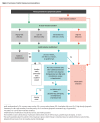Approach to risk stratification of atherosclerotic cardiovascular disease: Use of biomarkers and imaging in a Canadian context
- PMID: 36100373
- PMCID: PMC9470181
- DOI: 10.46747/cfp.6809654
Approach to risk stratification of atherosclerotic cardiovascular disease: Use of biomarkers and imaging in a Canadian context
Abstract
Objective: To outline the 2021 Canadian Cardiovascular Society (CCS) dyslipidemia guidelines and to present the current approaches to cardiovascular risk stratification, including the incorporation of biomarkers and imaging tests.
Sources of information: Current guidelines were reviewed and an Ovid MEDLINE literature search was performed.
Main message: Cardiovascular disease (CVD) is the leading cause of global mortality, with ischemic heart disease contributing to nearly half of these deaths. Risk stratification is undertaken to identify patients who would benefit from primary prevention for atherosclerotic CVD (ASCVD), but commonly used methods for risk stratification are imperfect. The CCS guidelines endorse that the presence of risk modifiers (family history of premature ASCVD, high-sensitivity C-reactive protein level ≥2.0 mg/L, lipoprotein[a] level ≥500 mg/L [≥50 mg/dL], or coronary artery calcium >0) supports the use of statin therapy in those at intermediate risk (Framingham risk score 10% to 19.9%) who do not otherwise meet the recommendations for statin use. The CCS guidelines recommend statin therapy in patients at intermediate risk when cholesterol levels are elevated (low-density lipoprotein cholesterol level ≥3.5 mmol/L, non-high-density lipoprotein cholesterol level ≥4.2 mmol/L, or apolipoprotein B level ≥1.05 g/L). In addition, statin therapy should be considered for patients at low risk (Framingham risk score 5% to 9.9%) with elevated cholesterol levels, especially if risk modifiers are present. When cholesterol levels are not elevated, evidence still favours the use of statins in intermediate-risk patients when risk modifiers are present and in men 50 years and older and women 60 years and older with 1 additional risk factor.
Conclusion: Biomarkers and imaging tests have the potential to improve ASCVD risk stratification by reclassifying any patient whose risk has been inaccurately estimated by traditional methods. Recently published guidelines by the CCS suggest the use of biomarkers and imaging in certain patient groups.
Copyright © 2022 the College of Family Physicians of Canada.
Figures
References
-
- Mancini GBJ, Gosselin G, Chow B, Kostuk W, Stone J, Yvorchuk KJ, et al. . Canadian Cardiovascular Society guidelines for the diagnosis and management of stable ischemic heart disease. Can J Cardiol 2014;30(8);837–49. Epub 2014 May 28. - PubMed
-
- Pearson GJ, Thanassoulis G, Anderson TJ, Barry AR, Couture P, Dayan N, et al. . 2021 Canadian Cardiovascular Society guidelines for the management of dyslipidemia for the prevention of cardiovascular disease in adults. Can J Cardiol 2021;37(8):1129–50. Epub 2021 Mar 26. - PubMed
-
- Wilson PW, D’Agostino RB, Levy D, Belanger AM, Silbershatz H, Kannel WB.. Prediction of coronary heart disease using risk factor categories. Circulation 1998;97(18):1837–47. - PubMed
MeSH terms
Substances
LinkOut - more resources
Full Text Sources
Medical
Research Materials

